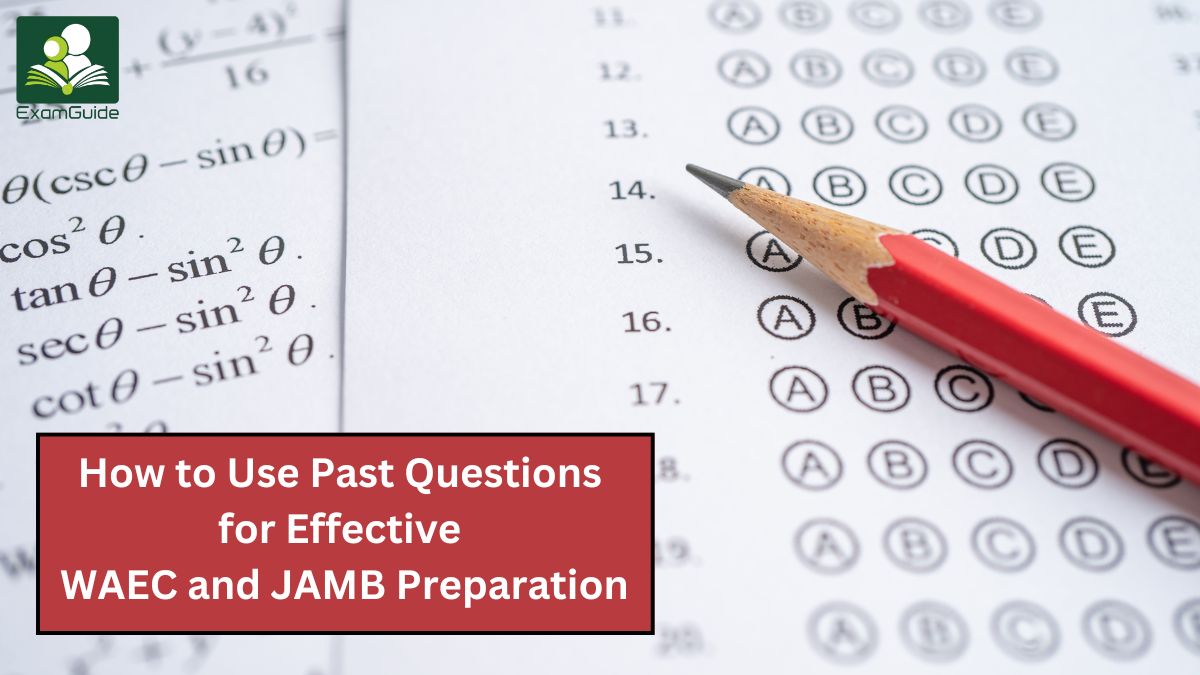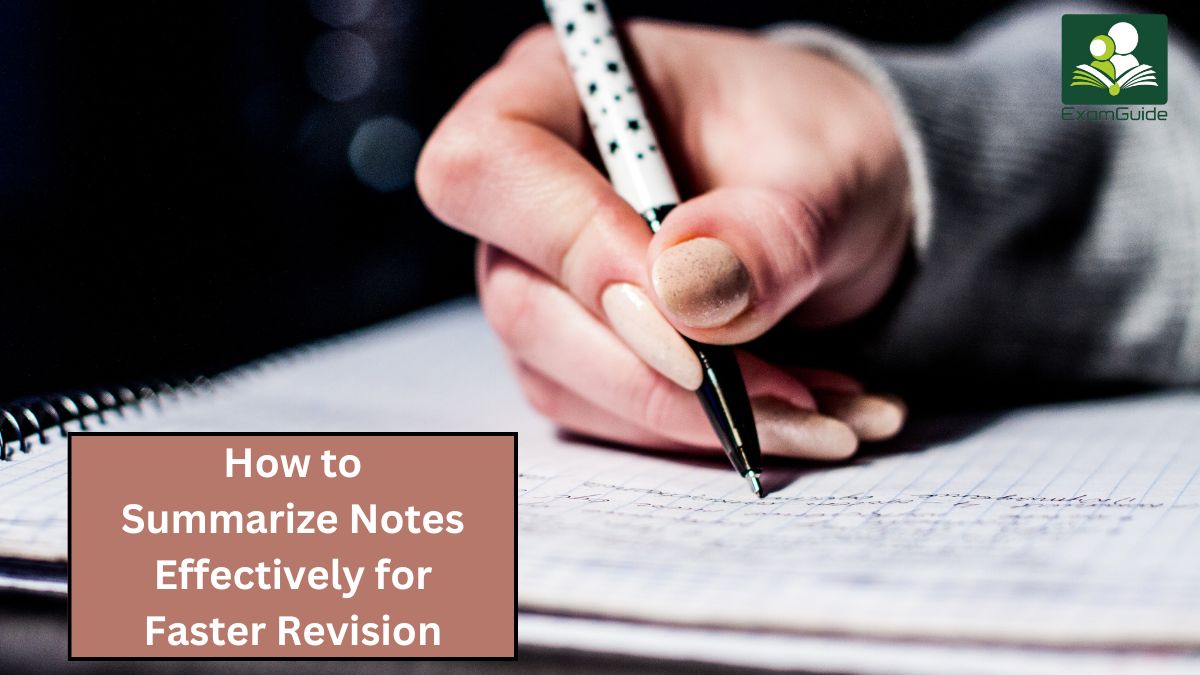
Importance of Past Questions in Exam Preparations
Preparing for exams can be a daunting task for students. It requires a well-structured approach to cover the vast syllabus and ensure a thorough understanding of the material. One of the most effective tools in this preparation process is using past questions.
These are previous years' exam papers or sample questions that provide insight into the format, structure, and type of questions that are likely to appear in the exams.
The following sections examine the various reasons past questions are invaluable in exam preparations.
Table of Content
Why are Past Questions Important for Exam Preparation?
How Do Past Questions Help in Understanding the Exam Format?
Can Past Questions Help in Identifying Important Topics?
In What Way Do Past Questions Build Confidence?
How Do Past Questions Aid in Time Management During Exams?
How to Effectively Use Past Questions for Exam Preparation
How Can Students Access Past Questions?
Should Past Questions be the Only Resource Used for Exam Preparation?
What are Past Questions?
Past questions, also known as past exam papers, previous years' questions, or old question papers, are the exam papers that were used in previous examinations. They are an invaluable resource for students preparing for upcoming exams as they offer a glimpse into the types of questions that have been asked historically, the structure and format of the exams, and the level of difficulty that can be expected.
Here are the key aspects of past questions:
Components of Past Questions
- Exam Format and Structure
- Question Types: Past questions include various types of questions such as multiple-choice questions (MCQs), short answer questions, essay questions, problem-solving questions, and practical or lab-based questions.
- Sections: Exams may be divided into multiple sections, each focusing on different topics or skills. Past questions help students understand how these sections are organized.
- Marking Scheme: These papers often come with a marking scheme that indicates how marks are allocated for each question or section.
- Content Coverage
- Subject Matter: Past questions cover the entire syllabus of the course or subject. They include questions on all major topics that have been taught over the years.
- Recurring Themes: By reviewing multiple past papers, students can identify topics or themes that frequently appear in exams.
- Difficulty Level
- Question Complexity: Past questions reflect the complexity and depth of understanding required to answer exam questions. This helps students gauge the difficulty level of the exam.
- Variation in Difficulty: Exams often include a range of questions from basic to advanced levels. Past questions showcase this variation, helping students prepare accordingly.
Why are Past Questions Important for Exam Preparation?
Past questions are important for exam preparation for several key reasons:
1. Familiarity with Exam Format
Understanding Structure: Past questions help students become familiar with the format and structure of the exam. This includes the types of questions (multiple-choice, short answer, essay), the number of sections, and the distribution of marks.
Reduced Anxiety: Knowing what to expect on the exam day can significantly reduce anxiety and boost confidence, as students are not caught off guard by the exam layout.
2. Identifying Key Topics
Highlighting Frequent Topics: Analyzing past questions can reveal which topics are frequently tested. This allows students to focus their study efforts on the most important areas, ensuring they cover the material that is most likely to appear on the exam.
Efficient Study: By identifying key themes and topics, students can prioritize their study time more effectively, concentrating on areas that need the most attention.
3. Enhancing Answering Techniques
Developing Strategies: Practicing with past questions helps students develop effective answering techniques. They learn how to structure their responses, manage their time during the exam, and prioritize questions based on their strengths and the marks allocated.
Understanding Marking Schemes: Reviewing model answers or marking schemes can provide insights into what examiners are looking for, helping students frame their answers to maximize their scores.
4. Building Confidence
Practice and Familiarity: Repeatedly practising with past questions builds familiarity with the types of questions and the exam conditions. This familiarity reduces exam-related stress and anxiety, leading to a more confident approach on exam day.
Positive Reinforcement: As students see improvement in their performance over time through practice, their self-belief and motivation increase, further boosting their confidence.
5. Improving Time Management
Timed Practice: Practicing past questions under timed conditions helps students improve their time management skills. They learn how to allocate appropriate time to each section or question, ensuring they can complete the exam within the allotted time.
Avoiding Pitfalls: Effective time management practice helps students avoid common pitfalls, such as spending too much time on one question and rushing through the rest.
6. Understanding Examiner Expectations
Insight into Preferences: By studying past questions, students can gain insights into examiner preferences and expectations. They can understand the level of detail required, common pitfalls to avoid, and specific terminology or concepts that are frequently tested.
Preparation: This understanding allows students to tailor their preparation to meet these expectations effectively, improving their chances of scoring higher.
7. Assessment Tool
Self-Assessment: Past questions serve as an excellent diagnostic tool. Students can use them to assess their strengths and weaknesses, identifying areas where they need further study or practice.
Targeted Revision: This targeted approach to revision ensures that students can address their weaknesses and consolidate their strengths before the exam, leading to better performance.
8. Encouraging Active Learning
Active Engagement: Engaging with past questions promotes active learning. Instead of passively reading textbooks or notes, students actively recall information, apply their knowledge, and think critically about how to answer questions.
Enhanced Retention: This active engagement enhances retention and understanding, leading to deeper learning and better long-term memory of the material.
9. Realistic Practice
Simulating Exam Conditions: Past questions provide a realistic practice experience, reflecting the actual difficulty level and style of questions that students will face. This realistic practice is valuable in preparing students for the challenges of the exam.
How Do Past Questions Help in Understanding the Exam Format?
Past questions are a valuable resource in understanding the format of an exam. They provide detailed insights into the structure, types of questions, and the way exams are set up.
Here’s a breakdown of how past questions help in understanding the exam format:
1. Identifying Question Types
Variety of Questions: Past questions show the range of question types that may appear in the exam, such as multiple-choice questions (MCQs), short answer questions, essays, problem-solving questions, and practical or lab-based questions.
Question Patterns: Students can identify recurring question patterns and formats, allowing them to anticipate how questions might be phrased or presented.
2. Understanding the Structure of the Exam
Section Layout: Past questions reveal how exams are structured in terms of sections. For instance, an exam might be divided into different sections that focus on various topics or skills.
Number of Questions: Students can see the typical number of questions in each section and the overall length of the exam, helping them to understand the breadth and depth of coverage.
3. Time Allocation
Timing Insight: By reviewing past exams, students can estimate the amount of time they might need to spend on each question or section. This helps in planning their approach to managing the time during the actual exam.
Balancing Time: Understanding the time allocation for different types of questions ensures that students do not spend too much time on one part at the expense of others.
4. Mark Distribution
Marking Scheme: Past questions often come with a marking scheme, showing how marks are allocated for each question or section. This helps students understand the weightage of different parts of the exam.
Scoring Priorities: Knowing how marks are distributed allows students to prioritize high-mark questions and understand the relative importance of each section.
5. Instructions and Guidelines
Exam Instructions: Past questions include instructions and guidelines that are typically provided at the beginning of exams. Familiarity with these instructions ensures that students do not miss critical information during the actual exam.
Answer Formats: Instructions on how to answer questions, such as whether to use bullet points or full sentences, can also be derived from past questions.
6. Level of Difficulty
Complexity Analysis: Reviewing past questions helps students gauge the difficulty level of the exam. They can understand whether the questions are straightforward or require critical thinking and complex problem-solving skills.
Preparation Benchmark: This insight helps in setting a benchmark for the level of preparation required to tackle the exam effectively.
7. Exam Trends
Historical Trends: Analyzing past questions over several years can reveal trends in the types of questions that are commonly asked. For example, certain topics may be consistently tested, or specific question formats might be preferred by examiners.
Predictive Value: Understanding these trends can help students predict the types of questions that might appear in future exams, allowing them to focus their preparation accordingly.
8. Reducing Uncertainty
Eliminating Surprises: Familiarity with past questions eliminates the element of surprise on exam day. Students know what to expect in terms of question types, structure, and difficulty, reducing anxiety and increasing confidence.
Exam Readiness: This preparedness ensures that students are not caught off guard by the exam format and can approach the exam with a clear strategy.
Can Past Questions Help in Identifying Important Topics?
Yes, past questions can significantly help in identifying important topics that are frequently tested in exams. By analyzing previous exam papers, students can gain insights into the areas of the syllabus that are emphasized by examiners.
Here’s how past questions help in identifying important topics:
1. Analyzing Recurring Themes
Frequency of Topics: By reviewing multiple years of past questions, students can identify which topics appear frequently. If a particular theme or subject is consistently tested year after year, it indicates its importance.
Pattern Recognition: Recognizing patterns in the types of questions asked about certain topics helps students understand which areas are considered essential by examiners.
2. Focused Revision
Targeted Study: Knowing which topics are frequently tested allows students to focus their revision on these key areas, ensuring they are well-prepared for questions that are likely to appear.
Efficient Use of Time: This targeted approach to studying helps students use their time more efficiently, concentrating their efforts on the most relevant and important content.
3. Weightage of Topics
Mark Allocation: Past questions often reveal the distribution of marks across different topics. Topics that consistently carry a higher weightage in terms of marks are likely to be important and should be prioritized in study plans.
Understanding Emphasis: This understanding helps students allocate their study time according to the significance of each topic in the overall exam.
4. Identifying Trends in Question Types
Variation in Questions: By examining how different topics are questioned, students can identify variations in question types, such as theoretical questions, practical applications, or problem-solving scenarios.
Adapting Preparation: This knowledge allows students to adapt their preparation strategies to not only cover important topics but also to understand the different ways these topics might be tested.
5. Insight into Exam Focus
Curriculum Priorities: Past questions can provide insights into the curriculum priorities set by educational authorities. Topics that are heavily featured in past exams are likely aligned with key learning objectives.
Alignment with Learning Outcomes: Ensuring that study efforts are aligned with these priorities helps students cover the most critical learning outcomes.
6. Cross-Referencing with Study Materials
Supplementary Study: Cross-referencing past questions with textbooks, class notes, and other study materials helps students identify important sections that may have been emphasized in lectures or study guides.
Comprehensive Coverage: This approach ensures comprehensive coverage of important topics, reinforcing understanding and retention.
7. Preparing for Variability
Range of Questions: While focusing on frequently tested topics, students should also be prepared for variability by understanding how questions on these topics have been framed differently over the years.
Broad Preparation: This helps in preparing for different angles or perspectives from which a topic might be questioned, ensuring a well-rounded understanding.
In What Way Do Past Questions Build Confidence?
Past questions build confidence by familiarizing students with the exam format, types of questions, and marking schemes. Practising with them helps improve answering techniques and time management, reduces exam anxiety by making the process more predictable, and reinforces knowledge through repeated exposure.
Seeing improvement in performance over time boosts self-assurance and preparedness, making students feel more confident about their ability to succeed in the actual exam.
How Do Past Questions Aid in Time Management During Exams?
Past questions aid in time management during exams in several ways:
- Practice with Timing: By using past questions to simulate exam conditions, students can practice answering questions within a set time limit, helping them gauge how much time to spend on each question.
- Understanding Question Length: Familiarity with the types and lengths of questions helps students estimate how long they should allocate to each section, ensuring they don't spend too much time on any single question.
- Prioritizing Questions: Past questions often reveal which types of questions are more time-consuming. This knowledge allows students to prioritize and tackle easier or higher-mark questions first.
- Developing Speed: Regular practice with past questions improves a student's speed and efficiency in reading, understanding, and answering questions, which is crucial for completing the exam on time.
- Building Stamina: Timed practice sessions help build the mental and physical stamina needed to maintain focus and performance throughout the entire exam period.
How to Effectively Use Past Questions for Exam Preparation
Using past questions effectively can significantly enhance exam preparation. Here’s a step-by-step guide to help you maximize their benefits:
1. Gather Past Questions
- Collect Resources: Gather as many past questions as possible from various years. Check online databases, and libraries, or ask teachers for copies.
- Organize by Topic: Organize the questions by topic or subject area for focused study sessions.
2. Understand the Exam Format
- Analyze Structure: Study the structure of past exams, including the types of questions, section distribution, and mark allocation.
- Note Instructions: Pay attention to any recurring instructions or guidelines provided in the exams.
3. Create a Study Plan
- Identify Key Topics: Use past questions to identify frequently tested topics and focus your study on these areas.
- Allocate Time: Plan your study sessions to cover all important topics, giving more time to areas where you feel less confident.
4. Practice Under Exam Conditions
- Simulate Exam Environment: Practice answering past questions in a quiet environment, simulating actual exam conditions.
- Use a Timer: Set a timer to adhere to the time limits of the actual exam, helping you manage your time effectively.
5. Review and Analyze Your Answers
- Mark Your Work: Use marking schemes or model answers to evaluate your responses.
- Identify Mistakes: Analyze any mistakes or areas where you struggled and understand why you made them.
6. Focus on Improvement
- Target Weak Areas: Pay special attention to topics or question types where you performed poorly and revise those areas thoroughly.
- Repeat Practice: Regularly practice with past questions to build familiarity and confidence.
7. Seek Feedback
- Consult Teachers or Tutors: If possible, ask teachers or tutors to review your answers and provide feedback.
- Discuss with Peers: Discuss difficult questions with classmates to gain different perspectives and solutions.
8. Develop Answering Strategies
- Plan Your Answers: For essay-type questions, practice planning your answers to ensure they are structured and coherent.
- Prioritize Questions: Learn to prioritize questions during the exam, answering easier or higher-mark questions first.
9. Monitor Progress
- Track Performance: Keep a record of your scores and improvement over time.
- Adjust Study Plan: Use your performance data to adjust your study plan, focusing more on areas that need improvement.
10. Stay Consistent
- Regular Practice: Make practising past questions a regular part of your study routine, not just a last-minute activity before exams.
How Can Students Access Past Questions?
Students can access past questions through various sources. Here are some common methods:
1. School or University Resources
- Libraries: Many educational institutions keep archives of past exam papers in their libraries. Students can borrow or photocopy these papers.
- Departmental Offices: Sometimes, academic departments maintain collections of past papers, which can be requested by students.
- Teachers and Professors: Instructors often have copies of past exams and can provide them to students upon request.
2. Online Resources
- Institution Websites: Many schools, colleges, and universities publish past exam papers on their official websites. Students can download these directly.
- Educational Platforms: Websites like Coursera, and other educational platforms often provide access to past papers for various subjects.
- Online Forums and Communities: Websites like Reddit, Quora, and specific student forums often have threads where students share past exam papers.
3. Student Organizations
- Study Groups: Joining study groups can be beneficial, as members often share past exam papers and other resources.
- Student Unions: University student unions or academic clubs sometimes have archives of past papers available for their members.
4. Educational Apps and Tools
- Apps: There are various educational apps designed to help students prepare for exams, many of which include past questions (e.g. ExamGuide).
- Online Databases: Some websites specialize in providing past exam papers for a wide range of subjects and educational levels.
6. Tutoring Centers
- Private Tutors: Tutors often have access to past questions and can provide them to their students as part of the tutoring service.
- Tutoring Centers: Many tutoring centres and cram schools keep collections of past exam papers for their students to practice with.
7. Peer Sharing
- Classmates: Sharing past exam papers with classmates can be a mutually beneficial way to access more resources.
- Alumni: Reaching out to former students who have previously taken the exams can provide valuable access to past papers.
Should Past Questions be the Only Resource Used for Exam Preparation?
No, past questions should not be the only resource used for exam preparation. While they are a valuable tool, relying solely on past questions can lead to a narrow and incomplete understanding of the subject matter.
Here are several reasons why a more comprehensive approach is essential:
1. Comprehensive Understanding
- Complete Coverage: Past questions may not cover every topic in the syllabus. Textbooks, lecture notes, and other study materials ensure you understand the entire curriculum.
- Clarity: Textbooks and academic papers provide detailed explanations and context that past questions may not offer, helping to build a strong conceptual foundation.
2. Updated Information
- Curriculum Changes: Syllabuses and exam formats can change over time. Relying solely on past questions may result in studying outdated material. Keeping up with the latest textbooks and course materials ensures you are studying the most current information.
- New Topics: New topics or changes in emphasis in the curriculum may not be reflected in older past questions.
3. Diverse Question Types
- Variety of Practice: Past questions provide a limited set of question types. Engaging with a variety of practice questions, including those in study guides and online resources, helps prepare for different question formats.
- Skill Development: Other resources such as problem sets, case studies, and practice quizzes help develop a broader range of skills and problem-solving techniques.
4. Depth of Knowledge
- In-Depth Study: Detailed study guides, lecture notes, and supplementary reading materials offer a deeper understanding of complex topics that past questions alone may not provide.
- Application and Analysis: Engaging with comprehensive resources helps in understanding the application and analysis aspects of the subject, which are critical for higher-order thinking questions.
5. Active Learning
- Interactive Learning: Online platforms, educational videos, and interactive apps provide engaging ways to learn and reinforce concepts through active participation.
- Discussion and Collaboration: Study groups and class discussions can provide new perspectives and insights that enhance understanding.
6. Feedback and Clarification
- Instructor Guidance: Teachers and tutors can provide feedback, clarify doubts, and explain concepts that might be confusing when studying alone.
- Peer Learning: Working with peers allows for discussion and clarification of difficult topics.
7. Developing Exam Techniques
- Exam Strategies: Beyond practising past questions, resources like exam strategy guides and workshops help develop techniques for time management, stress reduction, and effective answering.
Conclusion
Including past questions in exam preparation strategies is a proven method to enhance performance and achieve academic success. They provide familiarity with the exam format, help identify key topics, improve answering techniques, build confidence, and enhance time management skills.
Also, they offer insights into examiner expectations, serve as an assessment tool, encourage active learning, and provide realistic practice. By leveraging the benefits of past questions, students can approach their exams with greater preparation, confidence, and the potential for higher achievement.
No comment found
Related Posts

Top 20 Motivational Quotes for Students to Work Hard

How to Use Past Questions for Effective WAEC and JAMB Preparation

Language barriers in Nigerian Education and how to Overcome them

How to Excel in Mathematics: Tips for Nigerian Students

How to Summarize Notes Effectively for Faster Revision


